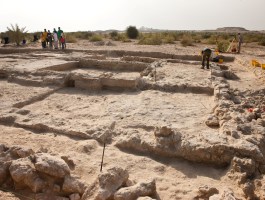The different layers in a trench that can be seen in section along the edges of an area being excavated. Archaeologists will draw a 2D plan of the stratigraphy from
the various areas of a site. Using this, it is possible to determine relationships between layers in different areas. For instance, if a house with 4 rooms has burnt down, you would expect a layer of
ash at about the same depth in each room.
In a wider context, stratigraphy can be used to draw relationships between different archaeological sites using the artefacts within it. Sometimes, even the type of
deposit can be used, such as the pumice layers from the eruption of Vesuvius in Pompeii and Herculaneum. This is particularly useful for 'relative dating', much like how palaeontologists compare
fossil layers, or geologists compare rock layers to work out if material was deposited earlier, at the same time, or later in relation to a particular layer.
Click image to enlarge.
Photo: canva.com















